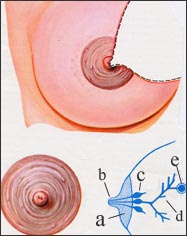임신 중 유방의 변화, Changes of breasts in pregnancy
임신이 되면 임신부의 신체에 여러 가지 변화가 생기기 시작한다. 그 중 하나가 유방의 변화이다. 임신이 되자마자 유방은 점점 커지기 시작해서 풍만해진다.
유방에 묵직한 감이 생긴다. 유방이 따끔따끔하고 얼얼거리고 가만가만히 만져도 아플 수 있고 단단해진다. 이런 증상은 2~3주 되면 자연히 없어지는 것이 보통이다.

젖을 먹이는 엄마의 젖꼭지
a-유두륜, b-젖꼭지, c-유동, d-세관, e-유선
소스-Pregnancy in Anatomical Illustrations, Carnation Healthcare Services, Los Angeles, CA 1962
임신에서 신생아 돌보기까지
임신 16주 경부터 젖꼭지의 색과 그 주위 유두륜의 피부색은 유방의 다른 부분의 피부색과 확연히 다르고 더 검어진다. 젖꼭지를 중심으로 직경 5〜8㎝ 둥근 부분을 유두륜 (Areola)이라고 한다. 유두륜의 표면에 두둘두둘한 좁쌀 만한 피부돌기가 여러 개 있다. 이런 피부돌기들은 몽고메리 선들이다. (그림 참조)
그 선들에서 피지가 분비되어 아기에게 젖을 먹일 때 젖꼭지와 유두륜이 부드럽게 된다. 젖을 먹일 때 아기의 위아래 입술로 전체의 유두륜을 다 덮을 수 있을 정도로 젖꼭지를 입안에 물리고 젖을 먹여야 한다. 그런 이유로 유두륜의 색이 유방의 다른 부분의 색과 구별이 되어 있는 것 같다.
임신 중 이런 유방의 변화들은 주로 에스트로젠과 프로제스테론의 영향을 받아 생긴다.
유두륜의 피부색은 각 임신부에 따라, 또 임신 개월 수, 임신부의 나이, 인종에 따라 조금씩 다를 수 있다.
임신하지 않은 성인 여성의 유두륜의 피부색은 검붉을 수 있지만 임신 중 유두륜의 피부색은 거의가 거무스름하다.
오돌오돌하고 좁쌀 만한 여러 개의 돌기들이 젖꼭지의 끝 부분에 나 있다. 이 돌기들은 젖이 나오는 젖구멍들이다.
에스트로젠과 프로제스테론 호르몬의 영향을 받아 유방 내 유관들이 새로 형성된다. 또 그 것들이 커지고 유선에 더 많은 가지가 형성된다. 이런 현상은 분만할 달에 더 가까워지면서 더 확연해진다.
임신 4개월 경부터 젖꼭지를 살짝 짜면 짙고 노란 젖이 한두 방울 나올 수 있다. 이 젖을 초유 (Clostrum, 마유)라고 한다.
초유는 이 때도 나올 수 있고 분만 후 처음 며칠간도 나올 수 있다. 분만 예정일에 가까워질 때 초유는 더 많이 분비될 수 있다. 분비된 초유가 젖꼭지에 말라붙으면 젖꼭지가 좀 가려울 수 있다.
젖꼭지가 가려우면 순한 비눗물로 씻은 후 마른 수건으로 물기를 말린다. 브래지어를 입지 않은 채 공기에 젖꼭지와 유방을 노출시키면 덜 가려울 수 있다.
Copyright ⓒ 2014 John Sangwon Lee, MD., FAAP
Changes of breasts in pregnancy 임신 중 유방의 변화
- When pregnant, various changes begin to occur in the pregnant woman’s body. One of them is breast changes.
- As soon as you become pregnant, your breasts start to grow larger and become fuller. There is a heavy sensation in the breast.
- The breasts are tingling, tingling, and even if you touch them gently, they can hurt and become hard.
- These symptoms usually disappear spontaneously in 2-3 weeks.

Breastfeeding mother’s nipples a-nipple ring, b-nipple, c-flow, d-tubule, e-streamline Source-Pregnancy in Anatomical Illustrations, Carnation Healthcare Services, Los Angeles, CA 1962
- From pregnancy to babysitting From the 16th week of pregnancy, the color of the nipple and the skin color of the nipple rings around it are significantly different from the skin color of other parts of the breast and become darker.
- The round part with a diameter of 5-8 cm around the nipple is called Areola. There are several narrow skin projections on the surface of the papillary ring.
- These skin projections are the Montgomery lines. (See picture) The glands secrete sebum, which softens the nipples and nipple rings when feeding the baby. When breastfeeding, breastfeeding should be done with the nipple in the mouth enough to cover the entire nipple ring with the baby’s upper and lower lips.
- For that reason, it seems that the color of the nipple rings is different from the color of other parts of the breast.
- These breast changes during pregnancy are primarily affected by estrogen and progesterone.
- The skin color of the nipple rings may vary slightly depending on each pregnant woman, the number of months of pregnancy, the age and race of the pregnant woman.
- The skin color of the nipple rings in a non-pregnant adult woman may be dark red, but the skin color of the nipple rings during pregnancy is almost dark.
- There are several small and narrow projections on the tip of the nipple.
- These protrusions are the apertures from which milk comes out. New ducts in the breast are formed under the influence of the hormones estrogen and progesterone.
- They also get bigger and more branches are formed in the streamline.
- This phenomenon becomes more pronounced as we get closer to the month of delivery.
- From around 4 months of pregnancy, lightly squeezing your nipples can result in one or two drops of dark yellow milk.
- This milk is called colostrum (horse oil). Colostrum can also come out at this time and in the first few days after delivery.
- More colostrum can be released as you get closer to your due date.
- If the secreted colostrum dries to your nipples, your nipples may be itchy.
- If your nipples are itchy, wash them with mild soapy water and dry them with a dry towel.
- Exposing your nipples and breasts to the air without wearing a bra can make it less itchy. Copyright ⓒ 2014 John Sangwon Lee, MD., FAAP
“부모도 반의사가 되어야 한다”-본 사이트의 내용은 여러분들의 의사로부터 얻은 정보와 진료를 대신할 수 없습니다.
“The information contained in this publication should not be used as a substitute for the medical care and advice of your doctor. There may be variations in treatment that your doctor may recommend based on individual facts and circumstances.
“Parental education is the best medicine.“